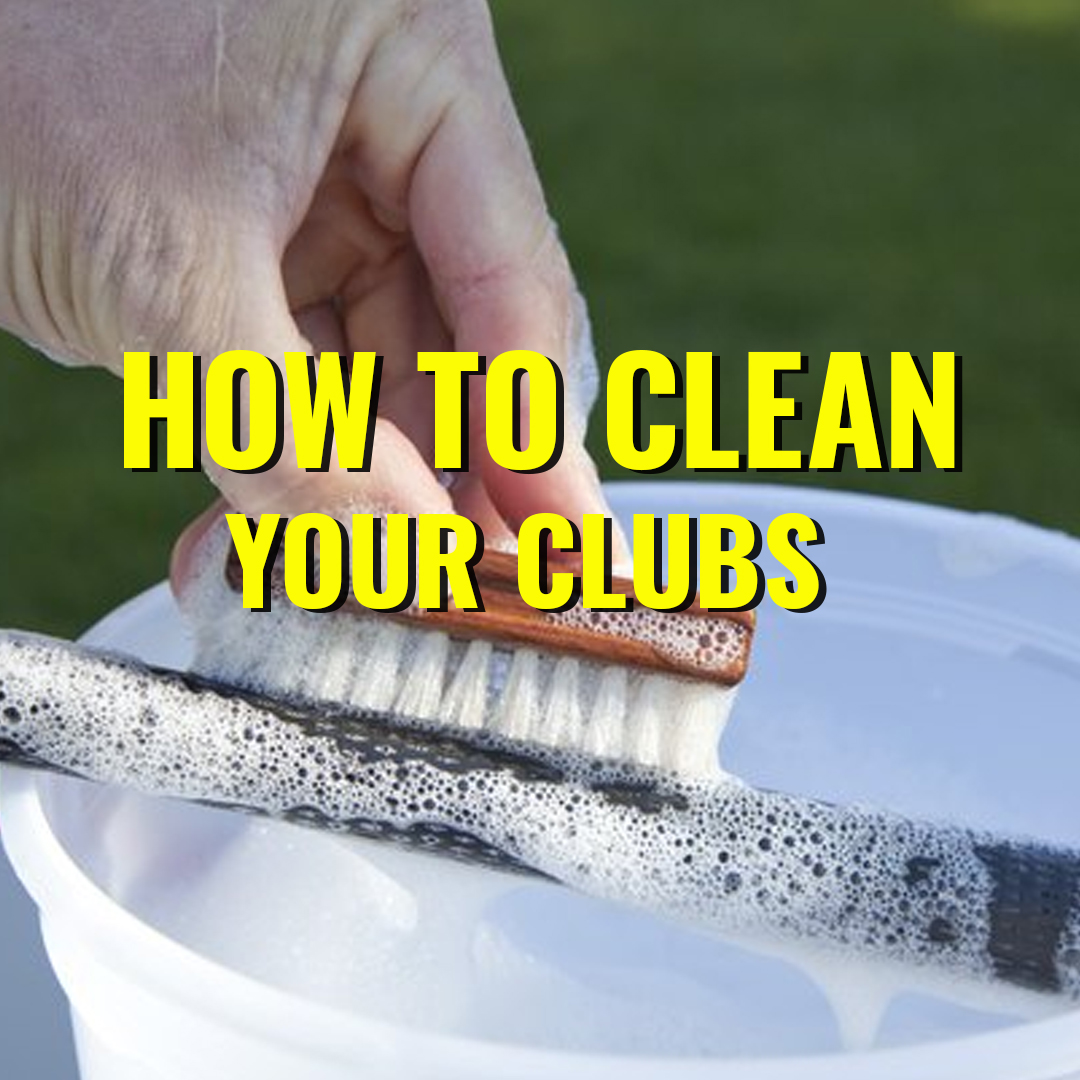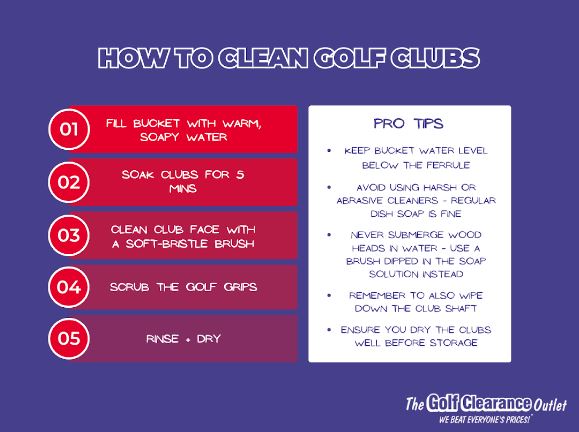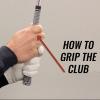How To Clean Golf Clubs

A great deal goes into achieving that elusive perfect round. Reaching your peak golf performance involves more than mastering your swing or sinking that perfect putt.
It all begins with one fundamental yet often overlooked aspect—the cleanliness of your golf clubs.
Your clubs are the unsung heroes that could be the difference between hitting a mediocre round and having a consistent and gratifying game.
In this article, we’ll bring you up to speed on everything you need to know about how to clean golf clubs so you can enhance your game and play at your optimum, every round.
|
Article Summary:
|
What to clean golf clubs with
Keeping your golf clubs in pristine condition doesn’t have to be difficult. Using only a few basic tools and items, you’ll be able to enjoy using a set of squeaky-clean clubs each time you hit the fairways.
What to use when cleaning golf clubs:
- bucket
- warm water
- a mild soap or detergent
- a soft-bristle brush
- microfibre towel
- metal polish (optional)
The best way to clean golf clubs
There are plenty of ideas out there about what the best way to clean golf clubs is, but in our experience, we’ve found it doesn’t need to be complicated—in fact, it only involves five simple steps to keep your clubs in optimal condition.
It is however important to note that you need to follow a slightly different process when cleaning irons and woods. Read on to find out more.
How To Clean Golf Clubs - Irons
- Fill a bucket with warm, soapy water
When filling the bucket, be sure to only fill it deep enough to cover the faces of your clubs. Any type of mild liquid dishwashing detergent is fine, just avoid using anything abrasive.
- Leave the clubs to soak for 5 minutes
Soaking the clubs allows any dirt and grime to soften, making them easier to clean.
When standing the golf clubs upright in the bucket, ensure the water level is below the club’s ferrule (the small strip just above the club hosel that connects the club head to the shaft). Submerging the clubhead above the ferrule could allow water to seep in and deteriorate the glue that holds the shaft and clubhead together.
- Use a soft-bristle brush to clean the clubface
Using a fit-for-purpose golf club cleaning brush is ideal, however, if you don’t have one a toothbrush will also work.
Gently brush the clubface, paying particular attention to the grooves to ensure you remove any dirt or build-up.
- Scrub the golf grips
Dip the golf grips in the soap solution, then give them a gentle scrub using the soft-bristle brush to remove any sweat and sunscreen residue.
- Rinse and dry the clubs
Once finished, give both the clubface and grips a quick rinse in some clean water, then use the microfiber towel to dry the club heads and grips, also remembering to wipe down the club shaft.
While following these five steps is all you need to do to keep your clubs clean and shiny, if you want your clubs to really sparkle, you can also opt to finish off the process by using a suitable metal polish. Just make sure you choose a polish that is non-abrasive and suitable for the material/s the club is made from.
How To Clean Golf Club - Woods
The cleaning process differs slightly between irons and woods.
When cleaning metal woods, it’s important not to submerge the club head in water as it could damage the club. Instead, dip the soft-bristle brush into the soapy solution and gently scrub the club head, ensuring it doesn’t get too wet. Finish by using the microfibre towel to dry the club head.
You can follow this same process when cleaning wooden woods—just pay some extra care not to be too rough when scrubbing the club head as wooden clubs tend to be significantly more fragile compared to newer, metal clubs.
How to clean golf grips
It’s also important to regularly clean the grips on your golf clubs to ensure they stay free from dirt, sweat, and oils to maintain a secure and comfortable grip and avoid the material degrading.
To clean golf grips, gently scrub and wipe down the grips using the same soap solution used to clean your clubs. Be mindful not to scrub too hard to avoid damaging the material.
If the grips become worn out, it might be time to purchase some replacement grips.
How to clean rust off golf clubs
Rust is a common issue for golf clubs which have been stored outside or in damp or unfavourable conditions. Thankfully, provided they’re not too far gone, a little rust shouldn’t be too difficult to remove. Generally, the sooner you deal with rust, the easier it should be to remove.
A mild amount of rust should be relatively easy to remove by following the same process described above. For more stubborn rust, you could also try using a non-abrasive metal polish.
Once you’ve successfully removed any rust, ensure you remember to give your clubs a thorough clean and dry after each round and store them appropriately in a cool, dry location to ensure the rust doesn’t return.
If you’re dealing with more moderate or heavy rust, it’s probably time to upgrade to a new set of golf clubs.
How often should you clean golf clubs?
How often your golf clubs need cleaning will depend on how often you play and the playing conditions. The more you play, the more often your clubs will need a thorough cleaning; similarly, if you’re playing in wet, muddy conditions, you’ll likely need to clean your clubs more often than if you’re playing in drier conditions
As a general guideline, it's recommended to clean your clubs after every round. However, playing in particularly muddy or wet conditions may call for both a mid-round brush and dry and a thorough post-round cleaning.
Ideally, it’s worthwhile giving your clubs a quick wipe-down after every shot. If you notice any dirt or grass lodged in the grooves, wipe them with a golf club cleaning brush or run a tee along the groove to dislodge it. This will not only ensure the club is ready for the next time you want to use it, but it will also keep your clubs in good nick, making the job easier when it’s time for a more intensive clean. If you consistently give them a good wipe-down on-course, you may even get away without needing to clean your golf clubs at the end of each round.
At an absolute minimum, you should always ensure you brush any dirt, grass and debris off the club heads at the end of every round. If you store your clubs away with dirt and residue still on the club head, your clubs will likely develop rust over time.
Why do you need to clean golf clubs?
Playing golf with a set of dirty golf clubs is like a chef trying to cook in a dirty kitchen. Just as a chef needs a clean kitchen to create their culinary masterpieces, a golfer needs a clean set of clubs to create a symphony of well-struck shots.
While you may still be able to round the course without experiencing too many dramas, a set of dirty clubs could impact your game in ways you may not realise. After all, if the cleanliness of your clubs didn’t have any impact on performance, why do tour pros have their caddies clean their clubs following each shot?
Here are a few of the reasons why it’s important to keep your golf clubs clean:
- Performance - Grooves that are filled with dirt essentially alter the profile of the club's face, affecting the way the club makes contact with the ball. The cleanliness of your clubs can affect everything from ball speed, launch angle and backspin to height, carry distance and descent angle, jeopardising accuracy and leading to less precise shots.
- Consistency - Playing with a set of clean clubs ensures a more consistent performance throughout your round. Dirt, grass and debris on the clubface can result in uneven strikes and hinder your ability to maintain a steady game.
- Spin and control - Clean grooves on your irons and wedges are crucial for generating spin and maintaining control over your shots. Dirty grooves can compromise these elements, impacting your ability to shape shots and hold greens.
- Club longevity - Regular cleaning helps prevent the build-up of dirt and grime, which can lead to corrosion over time. Keeping your clubs in good condition through proper cleaning extends their lifespan and protects your investment. Proper cleaning and maintenance may even increase the resale value of your clubs when you decide it’s time to upgrade to a new set.
- Aesthetics: It’s important to take pride in your equipment and keep it looking its finest. Not only will it impress your mates, but carting around a nifty-looking set of clubs can also contribute to the overall enjoyment of the game. After all, even if you can’t hit like a pro, at least you’ll look like one!
Cleaning your golf clubs is a simple and effective practice that can enhance multiple aspects of your game, so it’s well worth making post-round club cleaning part of your regular game routine.
Other considerations for cleaning golf clubs
Now you’re across the basics of how to clean golf clubs, here are a few other things to keep in mind to keep your clubs in tip-top condition.
- Always carry a microfibre towel and brush with you: It’s always worthwhile carrying a microfibre towel and soft-bristle brush in your golf bag during play for quick and easy cleaning between shots, especially on wet or muddy days.
- Steer clear of harsh or abrasive cleaners: It’s important to avoid using harsh or abrasive chemicals when cleaning golf clubs as they may damage the finish, grips or other components of your clubs. Instead, stick to mild soapy water.
- Remember to never fully submerge the club head: Submerging a golf club head in water can cause water to seep into the ferrule, potentially deteriorating the adhesive bond between the shaft and the clubhead and compromising the club's structural integrity and performance over time.
- Try to make cleaning part of your post-round routine: Make post-round club cleaning a habit. A few minutes spent cleaning your clubs immediately after a round can prevent stubborn dirt build-up and make deep cleaning sessions less frequent.
- Invest in quality head covers: It’s worth investing in a set of club head covers to protect your clubs during transport and storage. This helps prevent scratches and dings and can potentially extend the lifetime of your clubs.
- Make sure your clubs are properly stored in between use: Stowing your clubs away while they are still dirty or damp is likely to lead to corrosion. Make sure you always store your clubs in a cool, dry place and avoid leaving them in extreme temperatures or direct sunlight.
FAQs
Can you clean golf clubs with dish soap?
Absolutely. Most types of mild, household-grade dish soap are ideal for cleaning golf clubs. Just make sure you steer clear of any soaps that are abrasive or contain harsh chemicals that could damage the club’s surface. Remember to always rinse or wipe off any soap residue when finished
Does WD-40 clean golf clubs?
While WD-40 can be used to clean and remove rust from many types of clubs, it’s not usually necessary. Generally, you can keep your clubs nice and clean using nothing more than mild dish soap and warm water. WD-40 may also leave unwanted residue on your clubs.
Should I clean irons and drivers using the same method?
You can follow much of the same cleaning process, but avoid submerging the head of a driver in water. Instead, gently scrub the club head with a brush dipped in a soapy solution and dry when finished. Woods can also be more prone to damage from harsh brushing than irons, so opt for a softer, nylon-bristle brush.
Do I need to follow a different cleaning process for a wooden driver?
Wooden clubs can be more prone to damage compared to newer, metal clubs, so it’s important to handle them very carefully. While there’s a certain nostalgia to playing with a set of wooden clubs, if performance is important to you, consider if it may be time to upgrade to a new set.
Can I use a wire bristle brush to clean woods?
Woods can be more prone to damage from harsh brushing than irons. It’s best to use a brush with nylon bristles when cleaning wood and reserve wire bristle brushes for irons. Brushes like our retractable 2-sided brush feature dual nylon and brass brush heads, allowing you to clean your whole set with a single brush.












